Detective work and DNA trace the origins of Rice’s ‘moon tree’
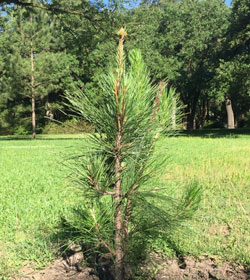
Rice’s moon tree is located near Main Street, nestled between the Gate 1 and Gate 2 roadways. (Photo courtesy of Scott Egan)
Near Main Street, nestled between the Gate 1 and Gate 2 roadways, grows an 18-inch pine tree. On a campus noted for its concentration of lovely trees – the Arbor Day Foundation has recognized the university twice in the last two years – the sapling might not seem like much. But looks can be deceiving.
The little pine appears to be little more than a small, needled shrub. It boasts fewer than five branches and the trunk is only about an inch thick. When it was planted in February 2016, it was roped off so it wouldn’t be accidentally crushed beneath a shoe or become the victim of a lawn mower.
And as delicate and meager as the tree was, and may still seem, there is untold strength in its stems and shoots. This little tree has done something that few humans have: It has traveled to the moon and back. Well, sort of.
Like any good story, this one has multiple layers, spans generations and even has a plot twist.
Once upon a time
To understand how “moon trees” even came into existence, you have to appreciate the background of NASA astronaut Stuart Roosa.
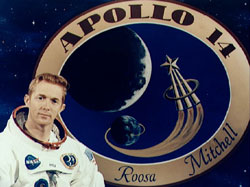
Apollo 14 astronaut Stuart Roosa began his career as a smokejumper with the U.S. Forest Service. (Photo courtesy of NASA)
Today astronauts are mostly scientists, doctors and researchers — academics. When Roosa entered the space program in 1966, astronauts were a bit wild, certainly brave and maybe even a little bit crazy. They were largely military men — former fighter and test pilots. Some were combat veterans and many held degrees in science or engineering.
Roosa began his career almost two decades earlier as a smokejumper for the U.S. Forest Service. Smokejumpers are firefighters who parachute out of airplanes into active, remote wildfires. In the fire season of 1953, Roosa made four such jumps in Oregon and California to protect and save wildlife.
Soon after that he entered the Air Force, where he served both as a fighter and test pilot and, eventually, found his way to the astronaut corps. By January 1971, Roosa was 37 years old and preparing to go to the moon.
And this is where his past with the Forest Service intersected with his future circling the moon.
In a land far, far away
On the Apollo missions, astronauts were afforded one personal bag on their space travels. As Roosa was preparing for spaceflight, a Forest Service administrator approached and asked if he would be willing to take the seeds of trees on a trip to the moon. The pitch: The seeds would take up minimal space in his personal pack and would be conceived of as both a publicity stunt and a scientific experiment.
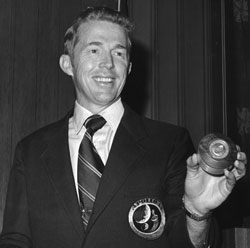
Stuart Roosa holding a canister of seeds. (Photo courtesy of the U.S. Forest Service)
Roosa liked the idea for multiple reasons: It could show the effects of zero gravity and exposure to radiation on plants; if the seeds survived and could be planted, it would provide media opportunities and exposure for the Forest Service. Records show that Roosa selected seeds from loblolly pine, sycamore, sweet gum, redwood and Douglas fir trees for the trip to the moon.
At just after 4 a.m. Jan. 31, 1971, and under heavy cloud cover, Apollo 14 blasted off from Cape Kennedy. It took four days to reach the moon and enter its orbit.
While astronauts Alan Shepard and Edgar Mitchell explored the lunar surface and Shepard famously hit golf balls into space, Roosa conducted experiments from orbit in the command module Kitty Hawk.
The mission — which lasted nine days, one minute and 58 seconds — was a success and the three astronauts, along with their payload, returned to Earth via a splashdown in the South Pacific. The seeds, secured in a canister about the size of a soda can, were among the cargo pulled aboard the U.S.S. New Orleans from the churning ocean.
Back to the future
In 2016, more than half a century after President John F. Kennedy delivered his famous “Moon Speech” at Rice Stadium, a “moon tree” landed on the Rice campus. But a lot had happened in 40-plus years, ranging from a tiny explosion to a deadly hurricane.
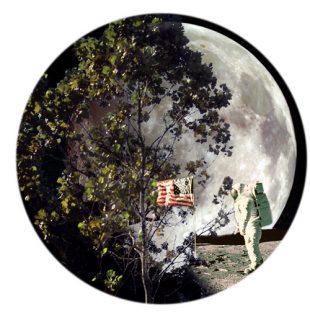
A promotional moon tree image. (Courtesy of NASA)
The first hiccup occurred not long after the mission ended. Many of the details have been lost to history, but it’s known that during the decontamination process, the canister holding the seeds was exposed to a vacuum and exploded. The seeds were scattered and mixed but able to be recollected, sorted and sent to research stations in Mississippi and California.
Despite early concerns about germination under such conditions — the rigor of space travel and unknown affects of weightlessness, coupled with the trauma of the canister bursting — more than 80 percent of the seeds sprouted. Some of those saplings were planted across the U.S. and world, but the majority took root at the research stations and were planted alongside control samples, their earthbound counterparts.
It was from one of those successfully sprouted moon trees that Rice’s was cultivated. And now, thanks to the work of Rice scientists from the lab of Scott Egan, assistant professor of ecology and evolutionary biology, we know more about the enigmatic origins of the Rice moon tree.
Well, sort of.
Finding its roots
Egan turned to colleague Vikram Chhatre, a geneticist who earned his doctoral degree from Texas A&M University studying the genetics of loblolly pines. Chhatre was able to link the Rice group with researchers at the Southern Research Station in Saucier, Miss.

Scott Egan
Egan and research technician Marie Jacobsen ’16 then took a small tissue sample made up of newly growing pine needles from the Rice tree, froze it at minus 80 degrees Celsius and shipped it on dry ice to their counterparts at the station. Forest Service scientists Sedley Josserand and Craig Echt were then able to extract DNA from the Rice sample and compare it with seven remaining loblolly pines.
The results were puzzling, Egan said.
“We learned that our moon tree was actually a graft from one of the moon trees at the research station,” Egan said. “The Rice moon tree is a loblolly pine grafted to a completely different species at its base — a slash pine.”
Grafting is a common horticultural technique for which the tissue of one plant is joined to another to continue their growth together. It is commonly used to propagate specific trees and make many more copies of a tree, he explained.
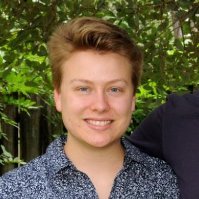
Marie Jacobsen
“Since we now know where the individual tree came from, we expected our tree’s DNA fingerprint to exactly match one of the seven moon trees genotyped, but it didn’t,” Egan said.
For a perfect match, there would have been 11 corresponding DNA markers. The best match was with “tree No. 5” at the station – but it matched only nine of 11 markers. In other words, the trees are very similar, but not exact matches.
How is that possible? Well, the scientists aren’t really sure, Egan said.
According to experts at the Forest Service, it’s possible for mutations to appear in different parts of a tree, including loblolly pines. These somatic mutations occur when a nucleotide base changes, which can include a substitution of one base for another or an insertion or deletion of a base in the DNA code. But experts say that it’s not likely, Egan said.
Happily ever after
A more likely explanation is that the specific tree that Rice’s tree was grafted from no longer exists but is a close relative to the ones at the station.
“We later learned that there was an eighth moon tree growing at the Harrison Experimental Forest that had been lost during Hurricane Katrina, so it may be that the Rice moon tree came from this eighth tree that was lost in 2005,” Egan said.
Additional analysis of the DNA results by Rice genomics technician Jennifer Drummond ’98 used clustered super computers to determine that Rice’s moon tree came from loblolly pine seeds collected in Louisiana. And that little seed was taken to the moon, returned to Earth and planted in Mississippi.
“This chimera moon tree was then donated to Rice University, where it now is growing happily,” Egan said.
Maybe it’s a mutant. Maybe it’s an orphan. We may never know for sure, but it’s definitely unconventional.

